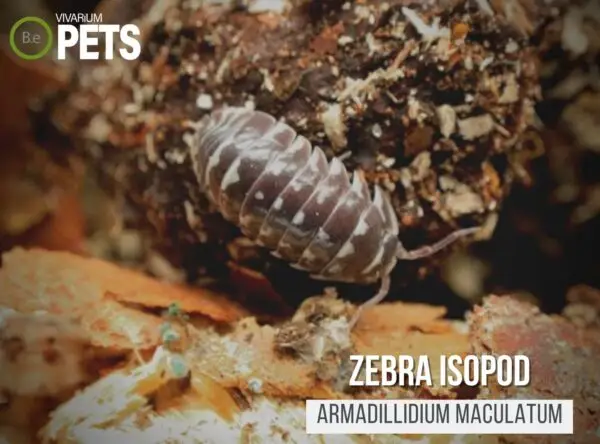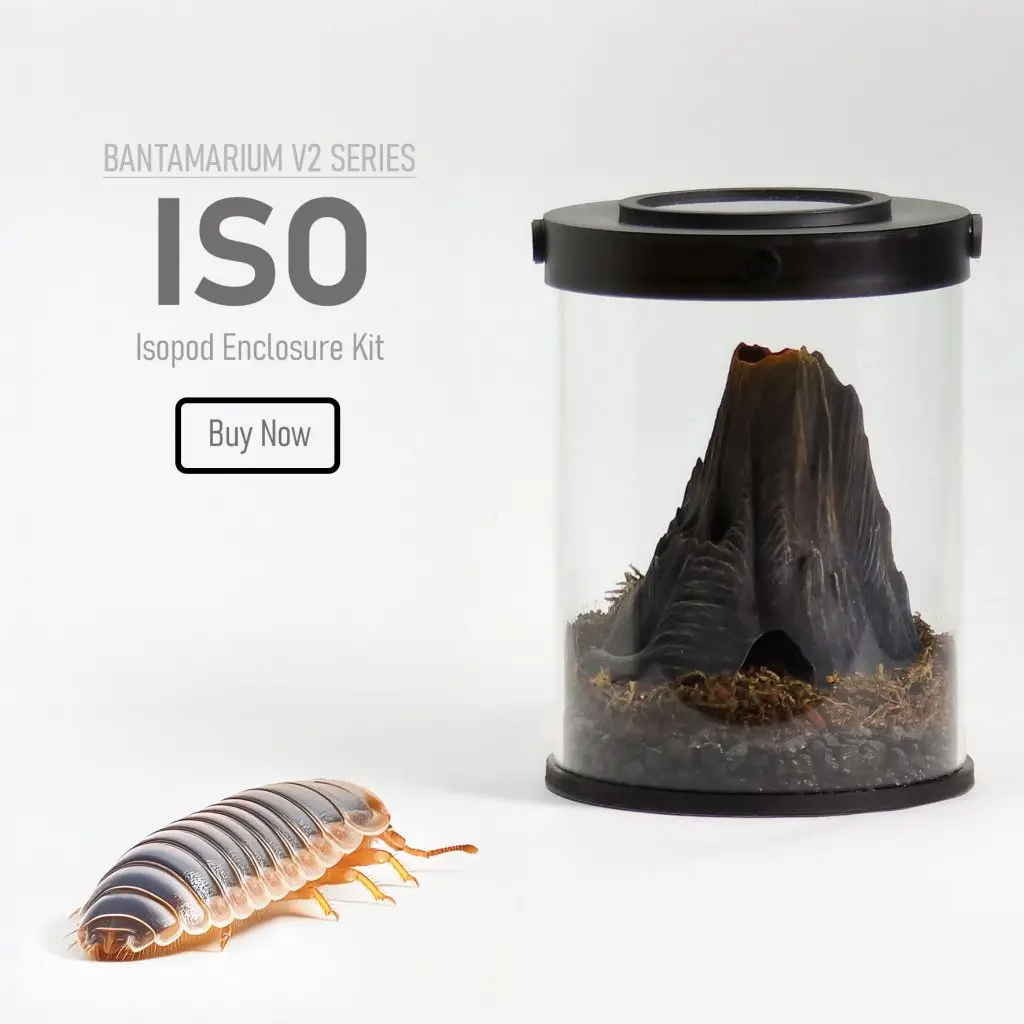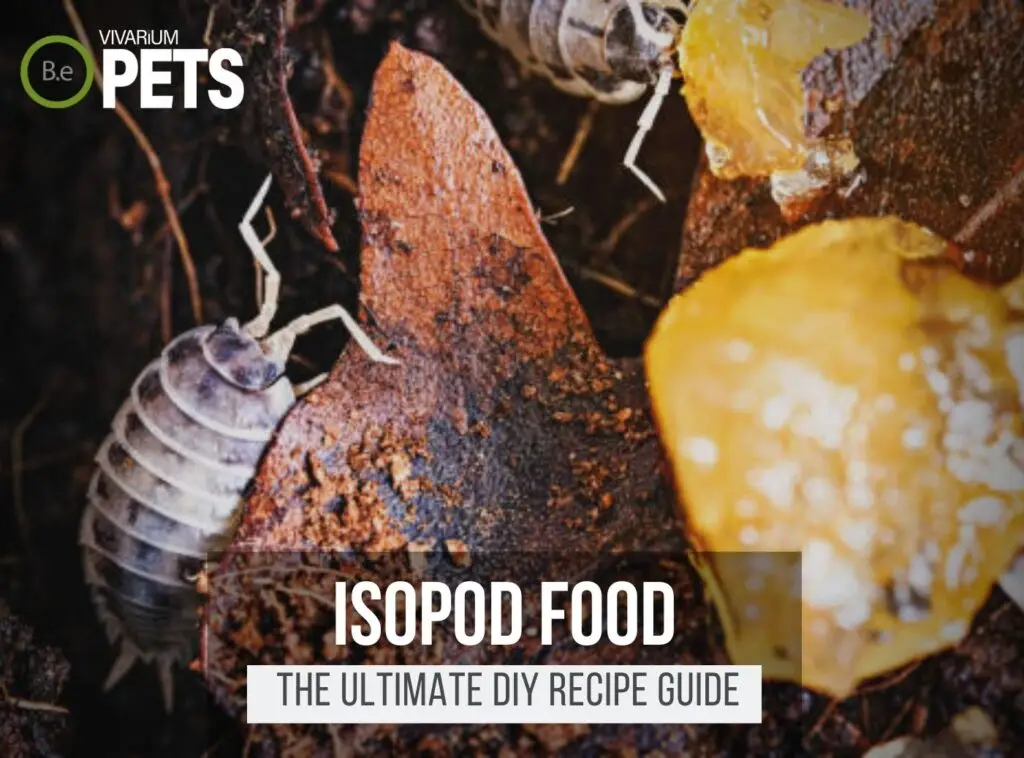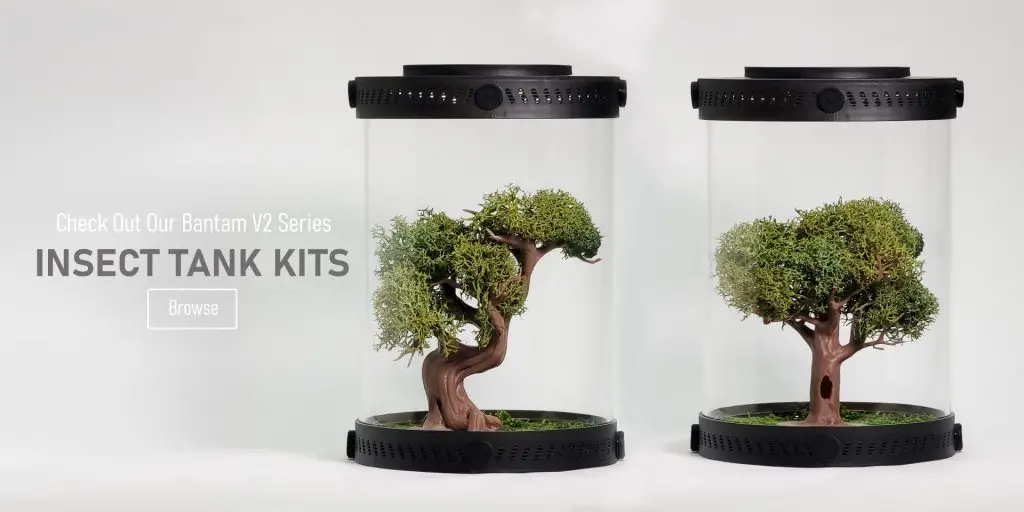Are you looking for a terrarium pet you can have fun watching but doesn’t require the same amount of commitment as frogs or reptiles?
Consider adding some Zebra Isopods (Armadillidium maculatum) to your home! These small terrestrial invertebrates are a great addition to any tank setup and require minimal care.
In this article, we’ll give you a comprehensive guide on how to set up a tank and care for Zebra Isopods.
From what they eat to common problems you might encounter, you’ll be an expert by the time you finish reading!
Table Of Contents:
ToggleWhat Are Zebra Isopods?
Zebra Isopods, or Armadillidium maculatum, is a type of woodlouse in the family Armadillidiidae.
They are a popular species of isopod to keep among hobbyists due to their attractive striped pattern on their exoskeleton which gives them their common name.
They are also interesting to observe as they go about their daily routines.
Create an ideal habitat for your Zebra Isopods with our Customizable Isopod Terrarium Kits, which include everything you need to get started.
What Do Zebra Isopods Look Like?
Zebra Isopods are small, terrestrial isopods that are typically 2 cm in length and have a distinct, black-and-white striped pattern along their entire body.
These markings help camouflage them in their natural environments, allowing them to blend into both dark and light backgrounds.
Despite their hard exoskeletons, Zebra Isopods are still quite flexible, making it possible for them to curl up into a tight ball when threatened.
Zebra Isopods have two antennae, several pairs of legs, and two sets of eyes.
They also have two sensory organs, called aesthetascs, which are located near their antennae and are used to detect changes in their environment.
Benefits Of Using Zebra Isopods
The use of Armadillidium maculatum in vivariums is a great choice for many reasons.
They are small and delicate, but also hardy and low-maintenance, making them perfect for the beginner or experienced pet keepers alike.
Not only are Zebra Isopods great pets, but they also work as vital elements of a healthy bioactive terrarium ecosystem.
Isopods are natural janitors as they consume a variety of decaying plant and animal matter.
This helps to keep the enclosure clean while providing an additional source of food for other beneficial species such as frogs or salamanders.
As they move around the tank, they aerate the substrate, preventing anaerobic decomposition.
This helps to minimize potential odors as well as create an environment that is both aesthetically pleasing and conducive to the health of the animals within.


Zebra Isopods Facts
Armadillidium maculatum are small, colorful invertebrates that make fascinating pets and require minimal care, with a lifespan of 1-3 years and very simple reproduction.
Zebra Isopods have a special structure on the tips of their antennae that allows them to detect food sources that are nearby.
They can also detect moisture in the air so they know when to search for food.
Habitat
Zebra Isopods are native to much of Europe. They are usually found among moist leaf litter in forests, wetlands, and grasslands.
In addition to Europe, Zebra Isopods have been introduced to parts of the United States. This includes Florida, California, and New Jersey, although the species is considered to be an invasive species in such locations.
They have also been found in China, but it is unclear whether their presence is due to a successful introduction or if they traveled more than 20,000 km to get there.
Replicate their natural habitat perfectly with our Bioactive Isopod Substrate Blend, designed to provide the ideal moisture and organic content for your isopods.
Diet
In Zebra Isopods’ natural habitat, they feed on dead or decaying plant matter to provide them with the necessary nutrients and minerals.
They can also consume fungi, small decaying insects, and even the remains of dead animals.
The decomposing material provides them with essential nutrients, minerals, and proteins which help to keep them healthy and active.
Temperament
Zebra Isopods are generally docile creatures and are not known to bite or harm humans or other animals.
They spend most of their time crawling around and burrowing in their substrate and will not typically interact directly with humans.
If a Zebra Isopod is disturbed, it will curl up in a ball and roll away, just like its armadillo counterpart.
They are not known to be skittish or have high energy and are usually quite content in their home environment.
Overall, Zebra Isopods should always be handled gently and with respect.
Lifespan
Armadillidium maculatum on average has a lifespan of 1-2 years.
They typically go through a life cycle of three stages: egg, juvenile, and adult.
The eggs can take anywhere from two weeks to a month to hatch, and the juveniles reach adulthood in two to three months.
After becoming an adult, a Zebra Isopod will breed during the summer months, producing another generation of juveniles that will take several months to reach adulthood.
Breeding
Zebra isopods breed through sexual reproduction.
They exhibit sexual dimorphism, which means that males and females can be distinguished by body shape and size.
Female isopods are typically larger than males and are distinguished by a curved mid-line running along their back. Males have a straighter mid-line, as well as longer antennae.
Mating usually takes place in the evening or during the night.
After mating, the female isopod releases dozens of eggs into a chamber in her body which is formed by extending the edges of her exoskeleton.
After a few weeks, the eggs hatch, and a young juvenile isopod emerges. These juveniles are called mancae, meaning ‘little claws’.
Because Zebra Isopods generally do not live in groups, breeding can be difficult in captivity. As such, keepers often separate males and females to ensure that they don’t breed too quickly.
In addition, individual males and females will often not reproduce unless they are provided with the right environmental conditions, including a suitable habitat and plenty of food.
Where To Find Zebra Isopods
Zebra Isopods are terrestrial isopods that live in temperate and tropical climates.
They can typically be found among leaf litter and vegetation in humid environments.
If you are seeking to find wild Zebra Isopods, your best bet is to search around your local wooded areas, or within logs and woodpiles.
Armadillidium maculatum can also be found for sale in any pet store, specialty retailer, or online.
If you are looking to purchase Zebra Isopods, you may want to look online first as many retailers specialize in the sale of these creatures.
Zebra Isopod Care
Armadillidium maculatum should be kept in a tank that is at least 10 gallons in size, with loose terrarium soil as the substrate and a temperature range between 18 and 25°C.
They should be fed a diet of fruits and vegetables, supplemented with calcium powder every few days.
To breed successfully, environmental factors must be optimum and both sexes should be present.
Tank Requirements
The ideal tank requirements for Zebra Isopods involve a vivarium with a pH between 7.2 to 8.2, a hardness between 6-10 dKH, and a temperature range of between 20-30 degrees Celsius.
I also recommend an ideal terrarium substrate such as sphagnum moss, coco fiber, or Vermiculite, and low-light, indirect terrarium lighting for about 8-10 hours a day.
Zebra Isopods prefer humid environments, so it is important to maintain humidity levels between 70-80% in the tank.
To maintain humidity levels and provide them with a suitable living environment, moss, and other live plants should be added to the tank.
Additionally, decoration, rocks, and driftwood should be added to the tank to fully simulate a natural habitat for the Zebra Isopods.
What Do Zebra Isopods Eat?
Feeding your Zebra Isopods doesn’t take much effort or time. They are omnivorous scavengers and will generally eat any organic material in their environment. Here are some of the things you can feed them:
- Vegetables such as cucumber, carrots, and mushrooms
- Fruits such as apples, bananas, and melons
- Shrimp pellets or other commercial isopod foods
- Leaf litter from a variety of trees and other plants
Feed your pet small amounts of the food once every couple of days. Too much food can cause overpopulation and sickness, so stick to the recommended amounts.
If you notice that the food you provide isn’t being eaten, remove it promptly and try something else.
If you’re more of an avid hobbyist like myself, be sure to check out my ultimate DIY Isopod food guide. I give a more in-depth explanation of the best foods and my favorite recipe.
Best Tankmates For Zebra Isopods
When setting up the tank for Zebra Isopods it is important to consider the best tankmates for them.
You want to make sure that you choose animals that won’t cause stress to your isopods or cause problems to the tank’s delicate ecology.
Good tankmates for Zebra Isopods include other isopods, snails, springtails, and small species of fish like guppies.
These animals help to keep the tank clean and provide plenty of surface area for your Zebra Isopods to enjoy and explore.
It is important to note that you want to be very selective with the species of animals you decide to add to the tank.
Certain types can be very aggressive and cause significant harm to your Zebra Isopods.
Smaller predatory animals, like crickets and scorpions, should be avoided as they can cause a lot of stress to your isopods and should never be kept in the same tank.
Conclusion
Congratulations on becoming an expert on Zebra Isopods! These interesting invertebrates are a catchy addition to any tank and are easy to care for.
With the information found in this article, you should now be able to provide your isopods with the ideal habitat and diet to ensure they stay happy and healthy.
Create the ideal habitat for your isopods with our species-specific soil mixes and Insect Enclosure Kits. These products provide everything you need for a successful and thriving isopod colony.
Frequently Asked Questions
Yes, Zebra Isopods are a great choice for beginner terrarium keepers as they are incredibly easy to care for and require minimal maintenance.
Zebra isopods typically reach a size of 1.8 cm in length when fully grown.
Yes, zebra isopods are relatively easy to breed. They have a short breeding cycle and reproduce quickly, making them an ideal species for beginning isopod enthusiasts.
Zebra isopods typically eat decaying organic matter, such as fruit, leaves, and wood. They also feed on algae and fungi.
Armadillidium maculatum ‘Zebra’ are best kept in a humidity range of 60–80%.
Zebra isopods grow at a moderate pace, typically reaching adulthood in between 6–10 months.
The common names for Armadillidium maculatum include Zebra Pillbug and Zebra Isopod.








